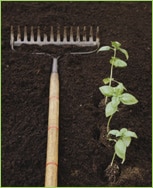Grass Planting Tips
When:
For spring-time seedings, plant anytime up to early May. Mid-April is an ideal time, and an oat-hay nurse crop could be included in the seed mix. Late summer and fall seeding is acceptable starting in about mid-August, (or early winter in southern climates) after the peak summer heat through about mid-September. Allow enough fall growing time for the development of an adequate root system in the new grasses.
Fertilize:
As with dry-land seeding, don’t apply fertilizers (or herbicides) to new grass seedlings until the grasses are in the three to five leaf stage. Consult a qualified professional for fertilizer recommendations. Also, most grass seedings don’t require fertilizer prior to establishment. Often applying fertilizer at planting only encourages unwanted weed competition. Wait until the grasses have established themselves, soil test and then fertilize according to recommendations.
Method:
Use either a drop or a cyclone seeder to seed your area. A drop seeder is more accurate in placing seed, especially if the wind is a problem. However, if the ground is rough or rocky, the cyclone seeder will be easier to use. Seed at the rates recommended for your grass mix. (up to 5 pounds per 1000 square feet) Divide seed into two equal parts. Sow half of the seed by crossing the area north to south and the other half by crossing east to west. Rake the seed into the soil as soon as possible after sowing to reduce the chances of it blowing or washing out. Soil cover also helps to protect the young seedlings from drying out. When sowing on slopes prone to erosion, cover the seeded area with a thin layer of mulch. Recommended mulches include clean straw (straw with no seeds in it), netting or single-layer matting of some kind.
If you have a small amount of seed or a large area, you can add volume by mixing clean, dry sand with the seed. This can help with an evener distribution of the seed and allows you a better visual mapping. Use 4 or 5 parts sand to 1 part seed. For small areas, broadcast seeds by hand. On larger areas, use a cyclone type fertilizer spreader. Rake lightly, if possible, covering seeds to no more than 1/8 inch or pull a section of chain-link fence behind an ATV or small tractor. This will cover the seed and save precious time.
To mix grass seed with wildflowers, use only non-turf forming species such as blue gramma, sheep fescue, or hard fescue in equal parts with flower seed. These are non-competitive and serve to control erosion. For the southeastern US, use non-rhizomatous Tall Fescue.
A Word About Large Areas:
Understand that moisture MUST be present for germination. Either seed in early Spring, planting just before the last hard frosts, and hope for adequate rain, or provide timely irrigation. You can also wait to seed until Fall, just before Winter (for a dormant seeding), the freeze/thaw temperatures of spring help to break the seed dormancy of some species of wildflowers.
Water:
If you have water from a central community system or a water well permit that allows outside irrigation, water the newly seeded areas frequently and lightly. Water enough to keep the soil moist but not so heavily as to cause soil washing and loss of the grass seed.
—————————————————————————————————-
Extracted From: Colorado State University Extension. 8/99. Reviewed 1/08. www.ext.colostate.edu

